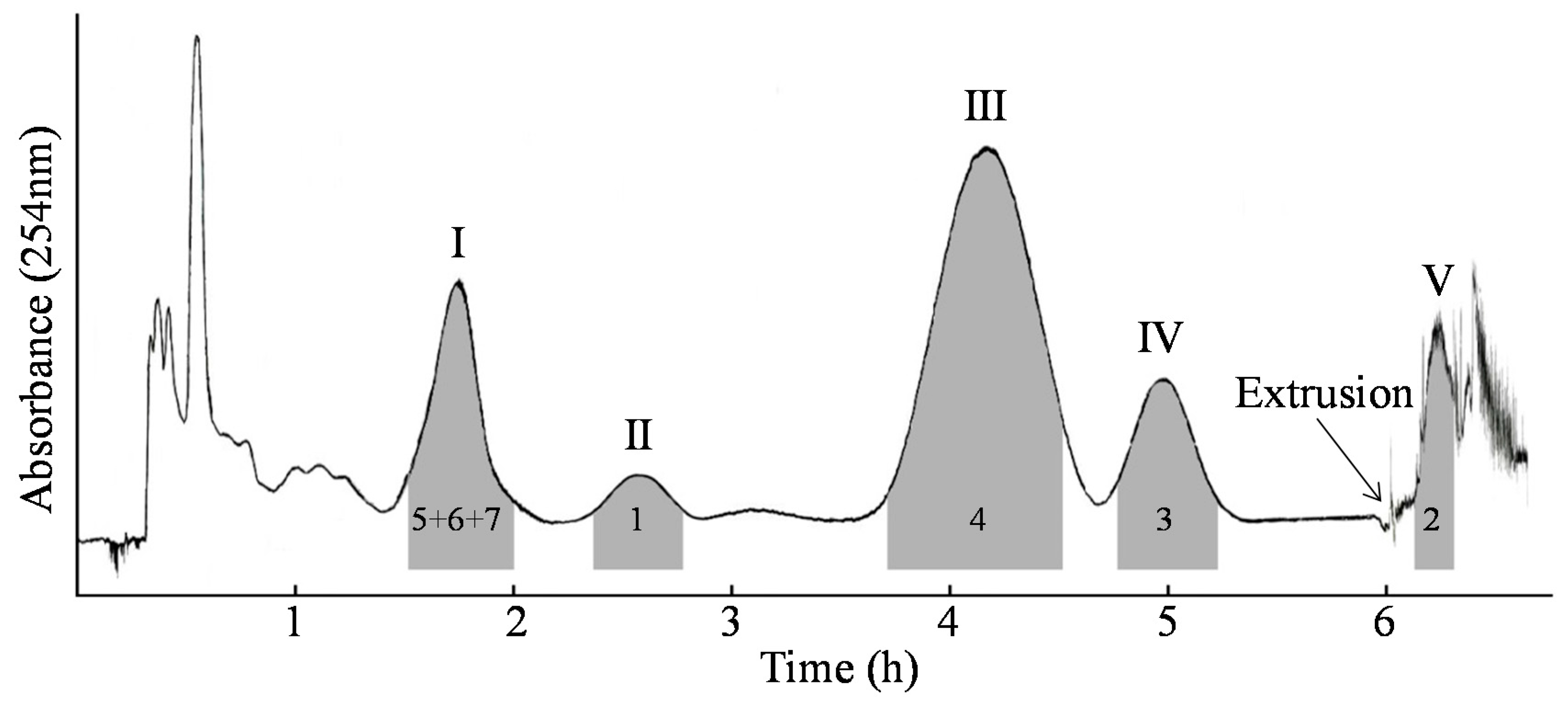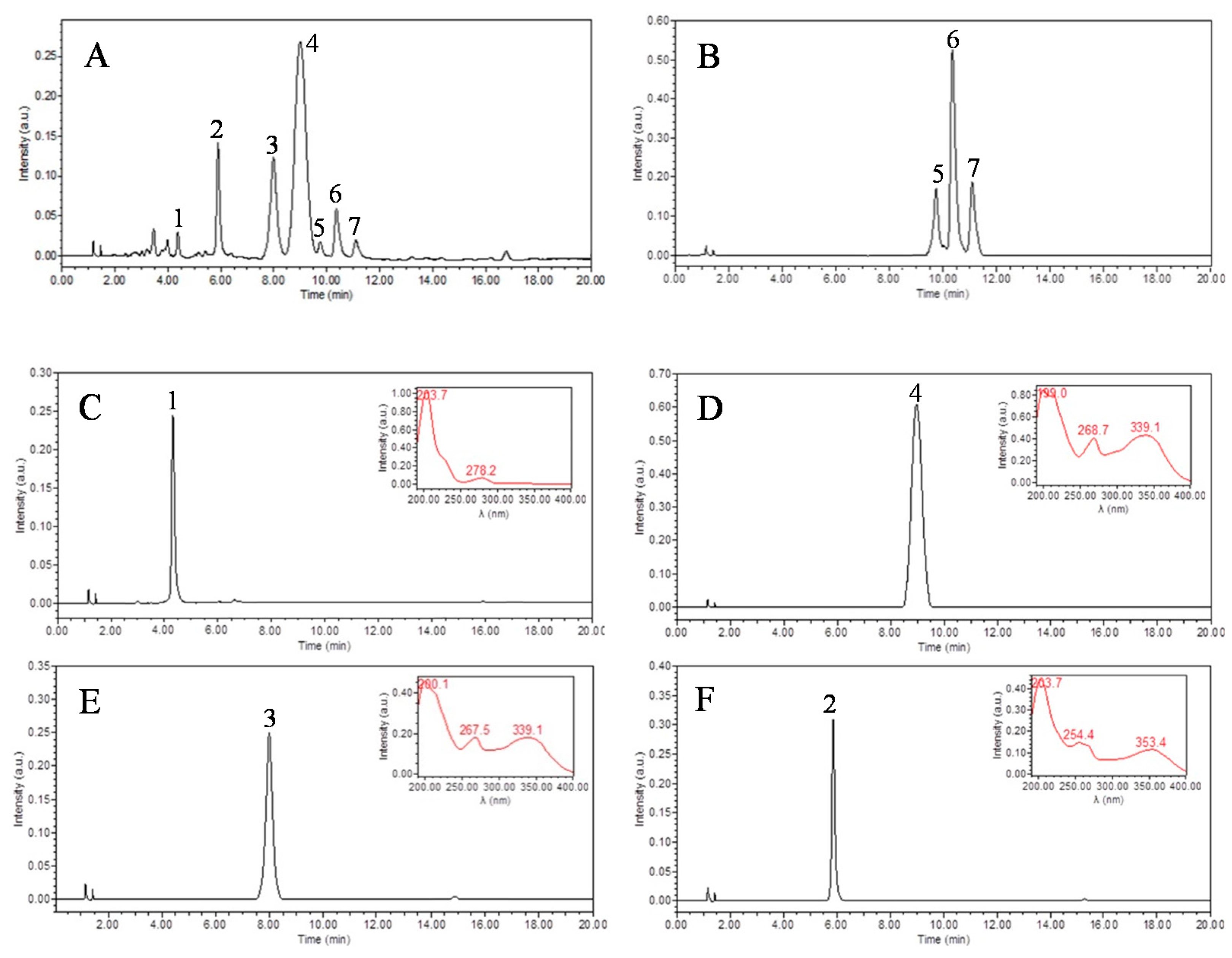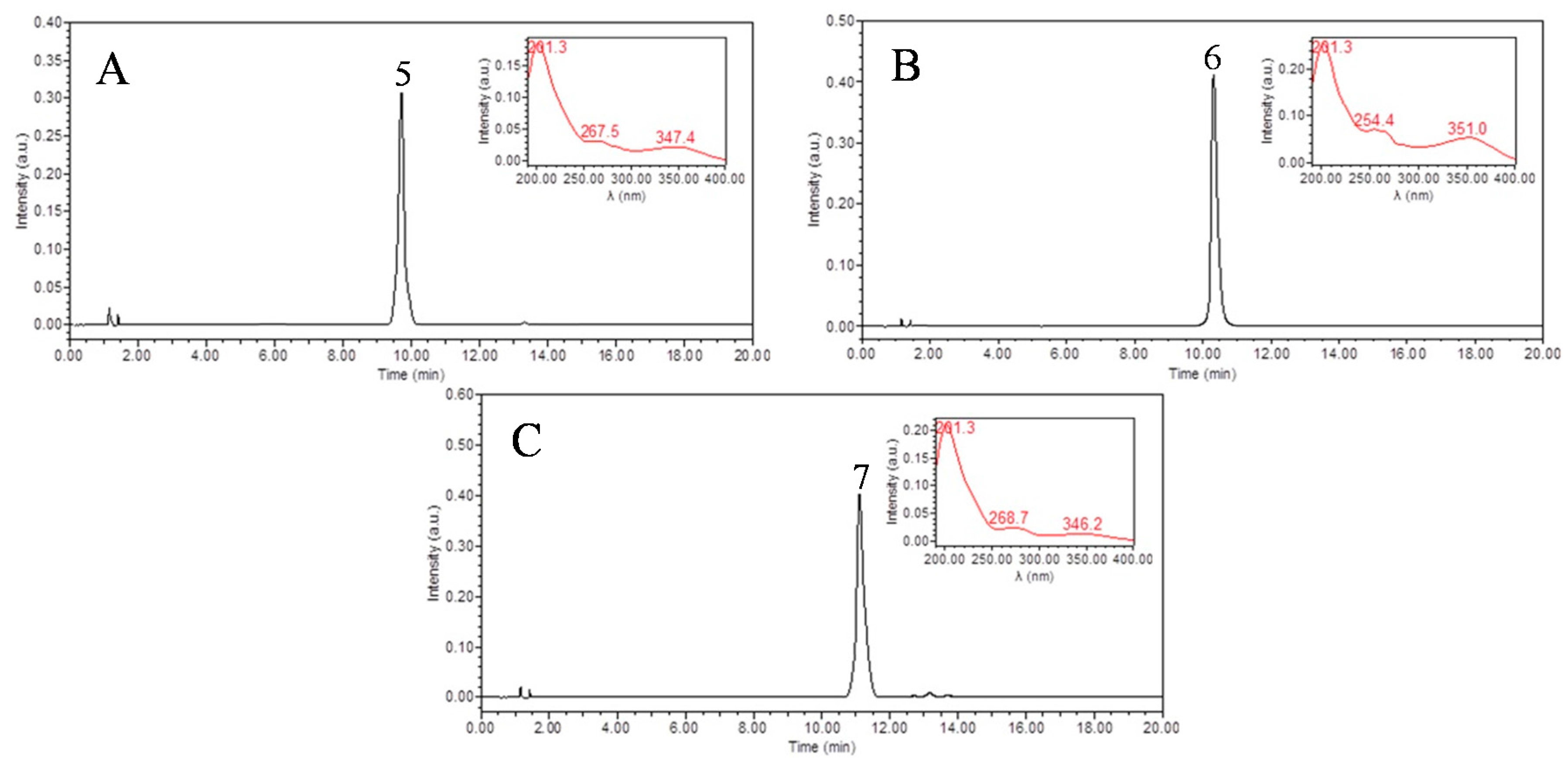An Efficient Method for the Preparative Isolation and Purification of Flavonoids from Leaves of Crataegus pinnatifida by HSCCC and Pre-HPLC
Abstract
:1. Introduction
2. Results and Discussion
2.1. Optimization of HSCCC Conditions
2.2. Pre-HPLC Separation
3. Materials and Method
3.1. Apparatus and Materials
3.2. Selection of the Two-Phase Solvent System
3.3. Preparation of the Two-Phase Solvent System and Sample Solution
3.4. HSCCC Separation Procedure
3.5. HPLC analyses of HSCCC and Pre-HPLC Peak Fractions
3.6. Electrospray Ionization Mass Spectrometry (ESI-MS) and Nuclear Magnetic Resonance Spectroscopy (NMR)
3.7. Identification of the Isolated Compounds
4. Conclusions
Acknowledgments
Author Contributions
Conflicts of Interest
References
- Committee of National Pharmacopoeia. Pharmacopoeia of P.R. China; Chemical Industry Press: Beijing, China, 2015. [Google Scholar]
- Wang, S.Y.; Xu, Q.Y.; Zhang, W.J.; Liu, X.; Ying, X.X.; Kang, T.G. Study on effects of hawthorn leaves extract on fatty liver in rats. Chin. J. Tradit. Chin. Med. Pharm. 2011, 26, 2955–2959. [Google Scholar]
- Wei, W.J.; Ying, X.X.; Zhang, W.J.; Chen, Y.H.; Leng, A.J.; Jiang, C.; Liu, J. Effects of vitexin-2′′-O-rhamnoside and vitexin-4′′-O-glucoside on growth and oxidative stress-induced cell apoptosis of human adipose-derived stem cells. J. Pharm. Pharmacol. 2014, 66, 988–997. [Google Scholar] [CrossRef] [PubMed]
- Cui, T.; Nakamura, K.; Tian, S.; Kayahara, H.; Tian, Y.L. Polyphenolic content and physiological activities of Chinese hawthorn extracts. Biosci Biotechnol Biochem. 2006, 70, 2948–2956. [Google Scholar] [CrossRef] [PubMed]
- Wu, J.Q.; Peng, W.; Qin, R.X.; Zhou, H. Crataegus pinnatifida: Chemical constituents, pharmacology, and potential applications. Molecules 2014, 19, 1685–1712. [Google Scholar] [CrossRef] [PubMed]
- Yang, B.R.; Liu, P.Z. Composition and health effects of phenolic compounds in hawthorn (Crataegus spp.) of different origins. J. Sci. Food Agric. 2012, 92, 1578–1590. [Google Scholar] [CrossRef] [PubMed]
- Zhang, P.C.; Xu, S.X. Flavonoid ketohexosefuranosides from the leaves of Crataegus pinnatifida Bge. var. major N.E.Br. Phytochemistry 2001, 57, 1249–1253. [Google Scholar] [CrossRef]
- Zhang, P.C.; Xu, S.X. C-Glucoside flavonoids from the leaves of Crataegus pinnatifida Bge. var. major N.E.Br. J. Asian Nat. Prod. Res. 2003, 5, 131–136. [Google Scholar] [CrossRef] [PubMed]
- Zhang, P.C.; Xu, S.X. Two New C-glucoside flavonoids from leaves of Crataegus pinnatifida Bge. var. major N.E.Br. Chin. Chem. Lett. 2002, 13, 337–340. [Google Scholar]
- Zhang, P.C.; Xu, S.X. Chemical constituents from the leaves of Crataegus pinnatifida Bge. Var. major N.E.Br. Acta Pharm. Sin. 2001, 36, 754–757. [Google Scholar]
- Svedström, U.; Vuorela, H.; Kostiainen, R.; Tuominen, J.; Kokkonen, J.; Rauha, J.P.; Laakso, I.; Hiltunen, R. Isolation and identification of oligomeric procyanidins from Crataegus leaves and flowers. Phytochemistry 2002, 60, 821–825. [Google Scholar] [CrossRef]
- Bykov, V.I.; Glyzin, V.I.; Ban’kovakii, A.I. Pinnatifidin-A new flavonol glycoside from Crataegus pinnatifida. Chem. Nat. Compd. 1972, 8, 699–701. [Google Scholar] [CrossRef]
- Gao, P.Y.; Li, L.Z.; Peng, Y.; Li, F.F.; Niu, C.; Huang, X.X.; Ming, M.; Song, S.J. Monoterpene and lignan glycosides in the leaves of Crataegus pinnatifida. Biochem. Syst. Ecol. 2010, 38, 988–992. [Google Scholar] [CrossRef]
- Huang, X.X.; Guo, D.D.; Li, L.Z.; Lou, L.L.; Li, D.M.; Zhou, C.C.; Peng, Y.; Song, S.J. Monoterpene and sesquilignan compounds from the leaves of Crataegus pinnatifida. Biochem. Syst. Ecol. 2013, 48, 1–5. [Google Scholar] [CrossRef]
- Tong, S.Q.; Shen, M.M.; Cheng, D.P.; Zhang, Y.M.; Ito, Y.; Yan, J.Z. Chiral ligand exchange high-speed countercurrent chromatography: Mechanism and application in enantioseparation of aromatic α-hydroxyl acids. J. Chromatogr. A 2014, 1360, 110–118. [Google Scholar] [CrossRef] [PubMed]
- Kang, J.; Gu, D.Y.; Wu, T.; Wang, M.; Zhang, H.; Guo, H.; Yin, Y.X.; Yang, Y.; Tian, J. An approach based upon the consecutive separation and the economical two-phase solvent system preparation using UNIFAC mathematical model for increasing the yield of high-speed counter-current chromatography. Sep. Purif. Technol. 2016, 162, 142–147. [Google Scholar] [CrossRef]
- Simirgiotis, M.J.; Schmeda-Hirschmann, G.; Bórquez, J.; Kennelly, E.J. The Passiflora tripartita (Banana Passion) Fruit: A Source of bioactive flavonoid C-glycosides isolated by HSCCC and characterized by HPLC-DAD-ESI/MS/MS. Molecules 2013, 18, 1672–1692. [Google Scholar] [CrossRef] [PubMed]
- Zhu, Y.D.; Liu, Y.; Zhan, Y.; Liu, L.; Xu, Y.J.; Xu, T.H.; Liu, T.H. Preparative isolation and purification of five flavonoid glycosides and one benzophenone galloyl glycoside from Psidium guajava by high-speed counter-current chromatography (HSCCC). Molecules 2013, 18, 15648–15661. [Google Scholar] [CrossRef] [PubMed]
- Ren, D.B.; Han, B.S.; Xin, Z.Q.; Liu, W.B.; Ma, S.S.; Liang, Y.Z.; Yi, L.Z. Computation-aided separation of seven components from Spirodela polyrrhiza (L.) via counter-current chromatography. Sep. Purif. Technol. 2016, 165, 160–165. [Google Scholar] [CrossRef]
- Gan, Z.L.; Liang, Z.; Chen, X.S.; Wen, X.; Wang, Y.X.; Li, M.; Ni, Y.Y. Separation and preparation of 6-gingerol from molecular distillation residue of Yunnan ginger rhizomes by high-speed counter-current chromatography and the antioxidant activity of ginger oils in vitro. J. Chromatogr. B 2016, 1011, 99–107. [Google Scholar] [CrossRef] [PubMed]
- Zhang, S.J.; Wu, W.Q.; Li, D.Y.; Zheng, Q.G. Separation and purification of six biosurfactant rhamnolipids by high-speed countercurrent chromatography utilizing novel solvent selection method. Sep. Sci. Technol. 2016, 51, 673–680. [Google Scholar] [CrossRef]
- Wang, D.J.; Geng, Y.L.; Fang, L.; Shu, X.K.; Liu, J.H.; Wang, X.; Huang, L.Q. An efficient combination of supercritical fluid extraction and high-speed counter-current chromatography to extract and purify (E)- and (Z)-diastereomers of α-asarone and β-asarone from Acorus tatarinowii Schott. J. Sep. Sci. 2011, 34, 3339–3343. [Google Scholar] [CrossRef] [PubMed]
- Xu, H.L.; Zhou, T.T.; Wen, J.; Fan, G.R.; Wu, Y.T. Isolation and purification of three flavonoids from the hawthorn leaves by high speed countercurrent chromatography, combined with isocratic preparative reversed-phase high performance liquid chromatography. J. Liq. Chromatogr. Relat. Technol. 2009, 32, 2216–2231. [Google Scholar]
- Ito, Y. Golden rules and pitfalls in selecting optimum conditions for high-speed counter-current chromatography. J. Chromatogr. A 2005, 1065, 145–168. [Google Scholar] [CrossRef] [PubMed]
- Liu, R.M.; Li, A.F.; Sun, A.L.; Cui, J.C.; Kong, L.Y. Preparative isolation and purification of three flavonoids from the Chinese medicinal plant Epimedium koreamum Nakai by high-speed counter-current chromatography. J. Chromatogr. A 2005, 1064, 53–57. [Google Scholar] [CrossRef] [PubMed]
- Shen, C.C.; Chang, Y.S.; Hott, L.K. Nuclear magnetic resonance studies of 5,7-dihydroxyflavonoids. Phytochemistry 1993, 34, 843–845. [Google Scholar] [CrossRef]
- Xie, C.; Xu, L.Z.; Luo, X.Z.; Zhong, Z.; Yang, S.L. Flavonol glycosides from Lysimachia capillipes. J. Asian Nat. Prod. Res. 2002, 4, 17–23. [Google Scholar] [CrossRef] [PubMed]
- Yasukawa, K.; Sekine, H.; Takido, M. Two flavonol glycosides from Lysimachia fortune. Phytochemisty 1989, 28, 2215–2216. [Google Scholar] [CrossRef]
- Rayyan, S.; Fossen, T.; Solheim Nateland, H.; Andersen, O.M. Isolation and identification of flavonoids, including flavone rotamers, from the herbal drug ‘Crataegi folium cum flore’ (hawthorn). Phytochem. Anal. 2005, 16, 334–341. [Google Scholar] [CrossRef] [PubMed]
- Choo, C.Y.; Sulong, N.Y.; Man, F.; Wong, T.W. Vitexin and isovitexin from the leaves of Ficus deltoidea with in-vivo α-glucosidase inhibition. J. Ethnopharmacol. 2012, 142, 776–781. [Google Scholar] [CrossRef] [PubMed]
- Deng, S.G.; Deng, Z.Y.; Fan, Y.W.; Peng, Y.; Li, J.; Xiong, D.M.; Liu, R. Isolation and purification of three flavonoid glycosides from the leaves of Nelumbo nucifera (Lotus) by high-speed counter-current chromatography. J. Chromatogr. B 2009, 877, 2487–2492. [Google Scholar] [CrossRef] [PubMed]
- Li, H.J.; Liu, Y.; Yi, Y.T.; Qin, M.; Liu, S.J.; Zhao, F.; Cong, W.; Wang, C.H.; Xia, C.H. Purification of quercetin-3-O-sophoroside and isoquercitrin from Poacynum hendersonii leaves using macroporous resins followed by Sephadex LH-20 column chromatography. J. Chromatogr. B 2017, 1048, 56–63. [Google Scholar] [CrossRef] [PubMed]
Sample Availability: Compounds are not available from the authors. |





| Solvent System | KD-Values | ||||||
|---|---|---|---|---|---|---|---|
| 1 | 2 | 3 | 4 | 5 | 6 | 7 | |
| n-Hex–EtOAc–MeOH–H2O (1:5:1:5, v/v) | 4.43 | 0.40 | 0.41 | 0.12 | <0.1 | 0.34 | 0.21 |
| n-Hex–EtOAc–EtOH–H2O (1:1.6:1:1.6, v/v) | 0.12 | <0.1 | <0.1 | <0.1 | <0.1 | 0.19 | 0.22 |
| CHCl3–MeOH–H2O (4:3:2, v/v) | 7.62 | >30 | 13.95 | 10.43 | 4.39 | 4.05 | 4.11 |
| CHCl3–MeOH–H2O–n-BuOH (4:3:2:0.5, v/v) | 5.13 | >30 | 12.25 | 8.04 | 3.46 | 3.02 | 3.12 |
| CHCl3–MeOH–H2O–n-BuOH (4:3:2:1, v/v) | 3.88 | 26.49 | 8.30 | 7.68 | 3.25 | 2.91 | 2.99 |
| CHCl3–MeOH–H2O–n-BuOH (4:3:2:1.5, v/v) | 2.15 | 18.91 | 4.78 | 3.35 | 1.47 | 1.33 | 1.34 |
© 2017 by the authors. Licensee MDPI, Basel, Switzerland. This article is an open access article distributed under the terms and conditions of the Creative Commons Attribution (CC BY) license (http://creativecommons.org/licenses/by/4.0/).
Share and Cite
Wen, L.; Lin, Y.; Lv, R.; Yan, H.; Yu, J.; Zhao, H.; Wang, X.; Wang, D. An Efficient Method for the Preparative Isolation and Purification of Flavonoids from Leaves of Crataegus pinnatifida by HSCCC and Pre-HPLC. Molecules 2017, 22, 767. https://doi.org/10.3390/molecules22050767
Wen L, Lin Y, Lv R, Yan H, Yu J, Zhao H, Wang X, Wang D. An Efficient Method for the Preparative Isolation and Purification of Flavonoids from Leaves of Crataegus pinnatifida by HSCCC and Pre-HPLC. Molecules. 2017; 22(5):767. https://doi.org/10.3390/molecules22050767
Chicago/Turabian StyleWen, Lei, Yunliang Lin, Ruimin Lv, Huijiao Yan, Jinqian Yu, Hengqiang Zhao, Xiao Wang, and Daijie Wang. 2017. "An Efficient Method for the Preparative Isolation and Purification of Flavonoids from Leaves of Crataegus pinnatifida by HSCCC and Pre-HPLC" Molecules 22, no. 5: 767. https://doi.org/10.3390/molecules22050767






